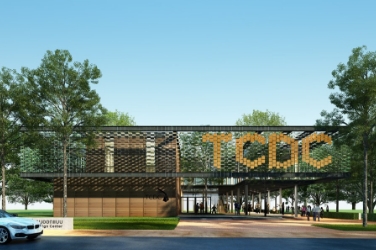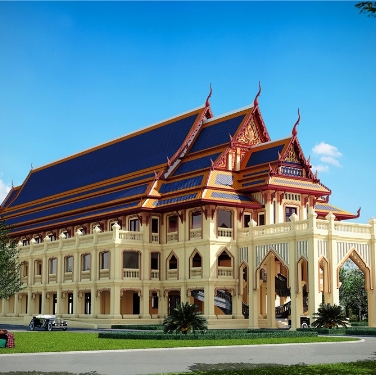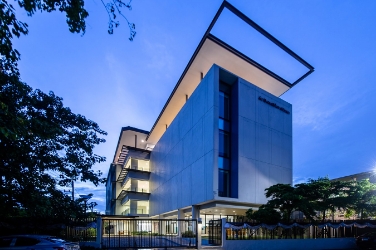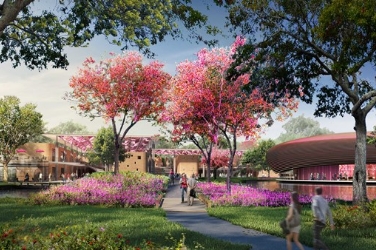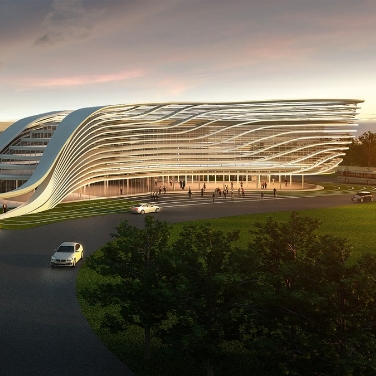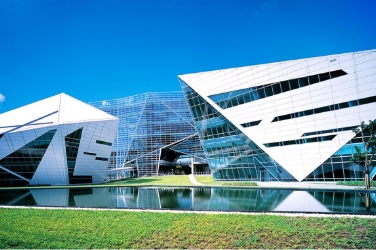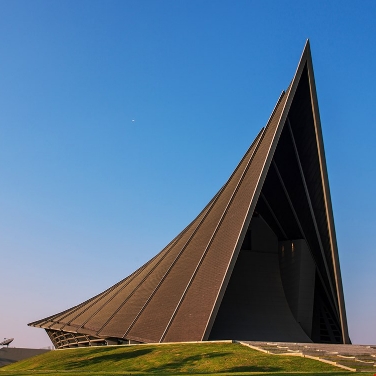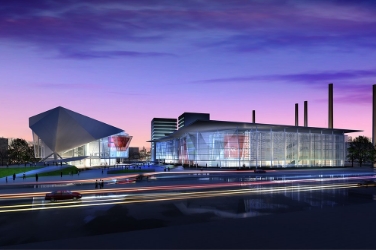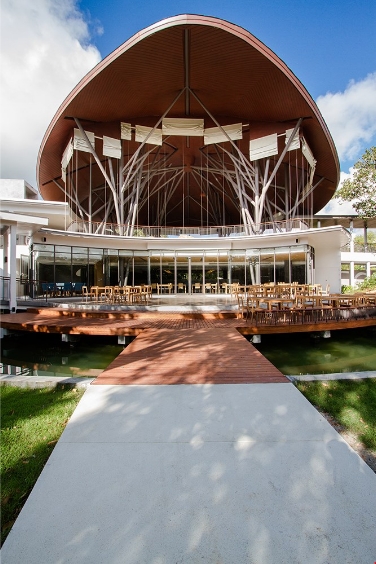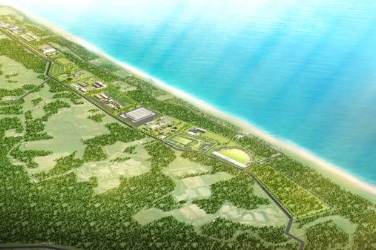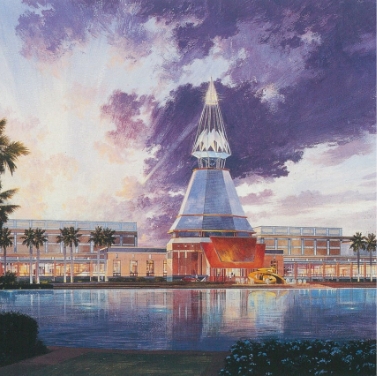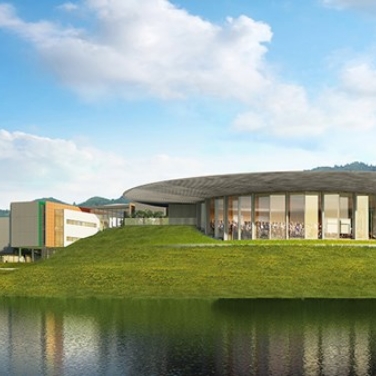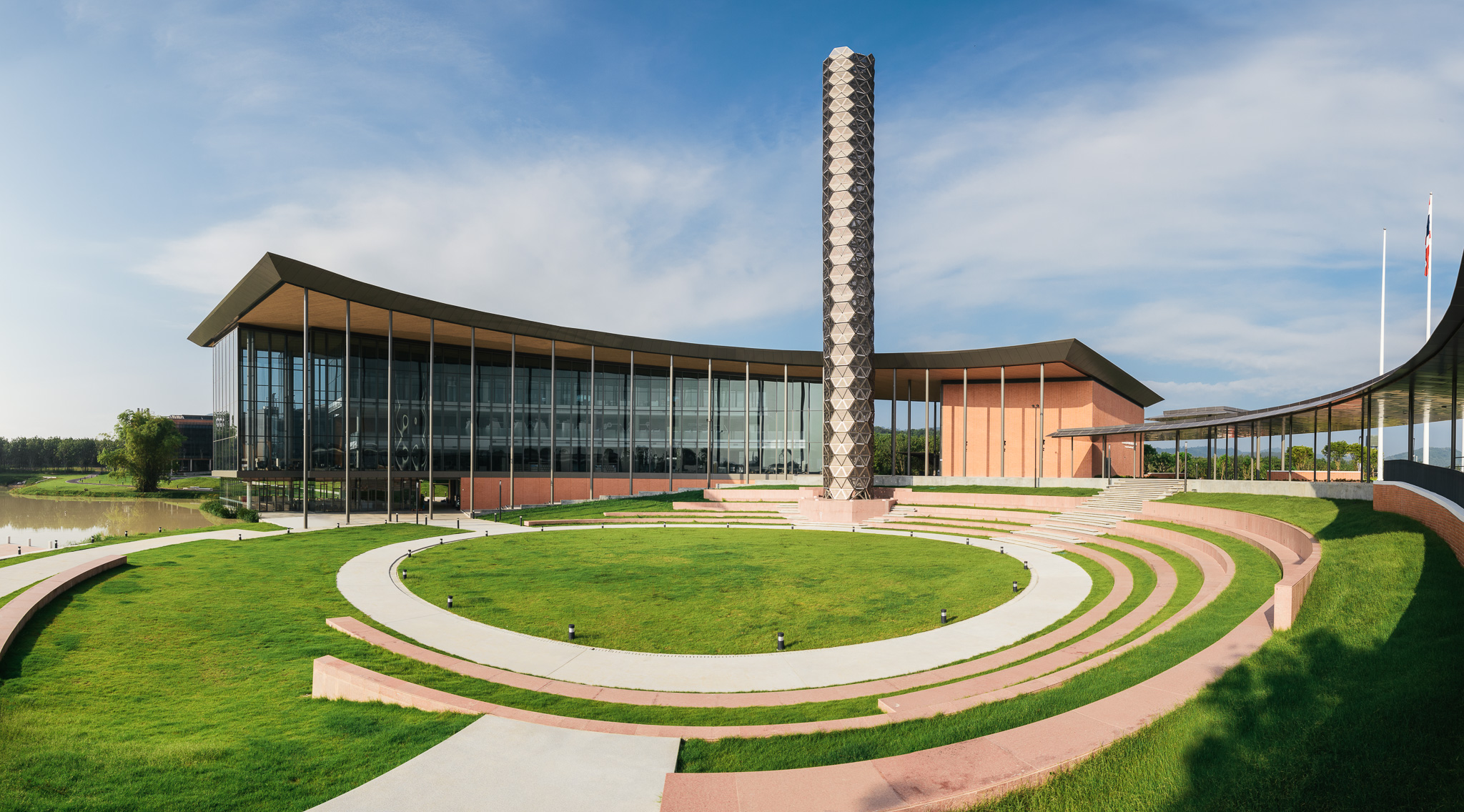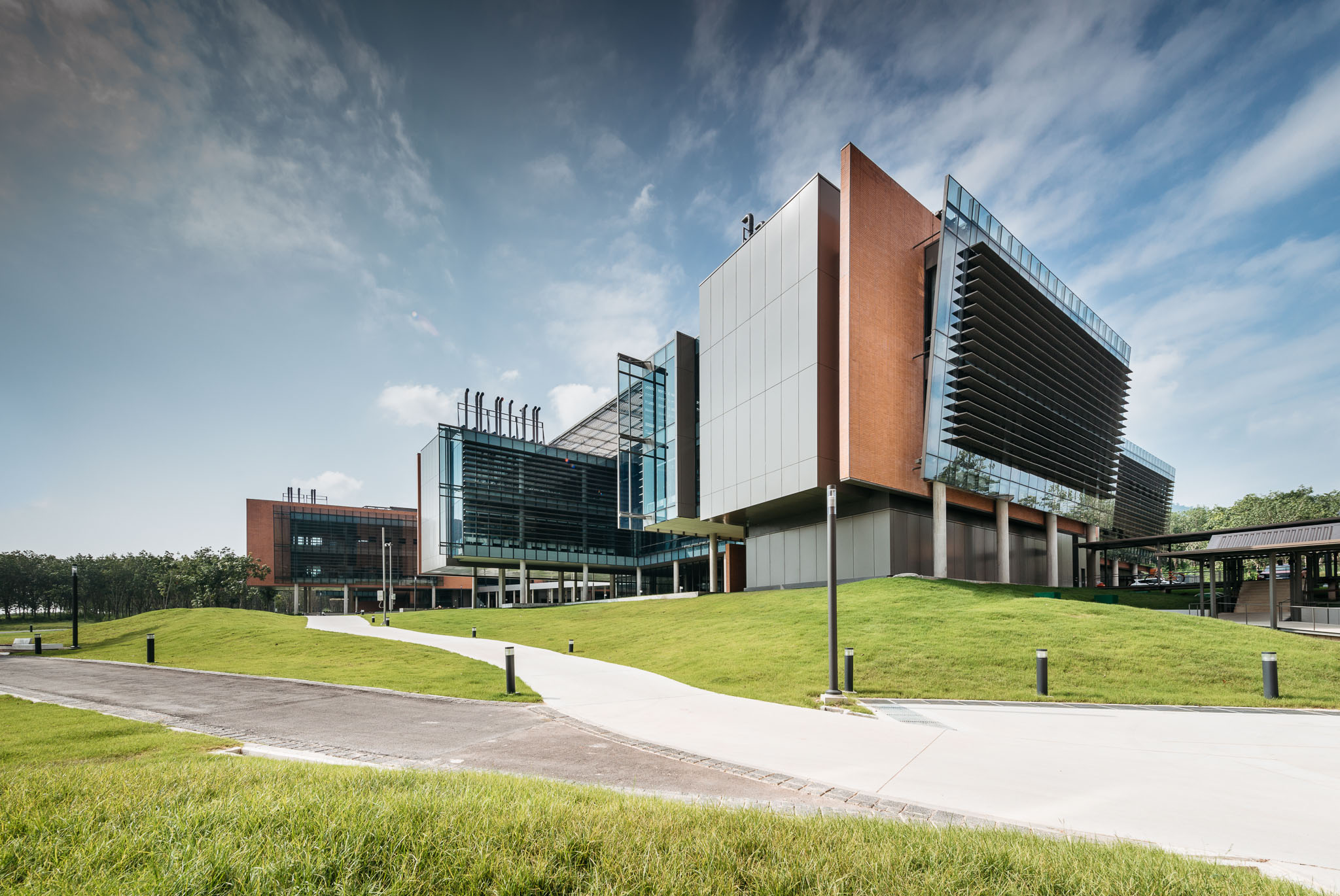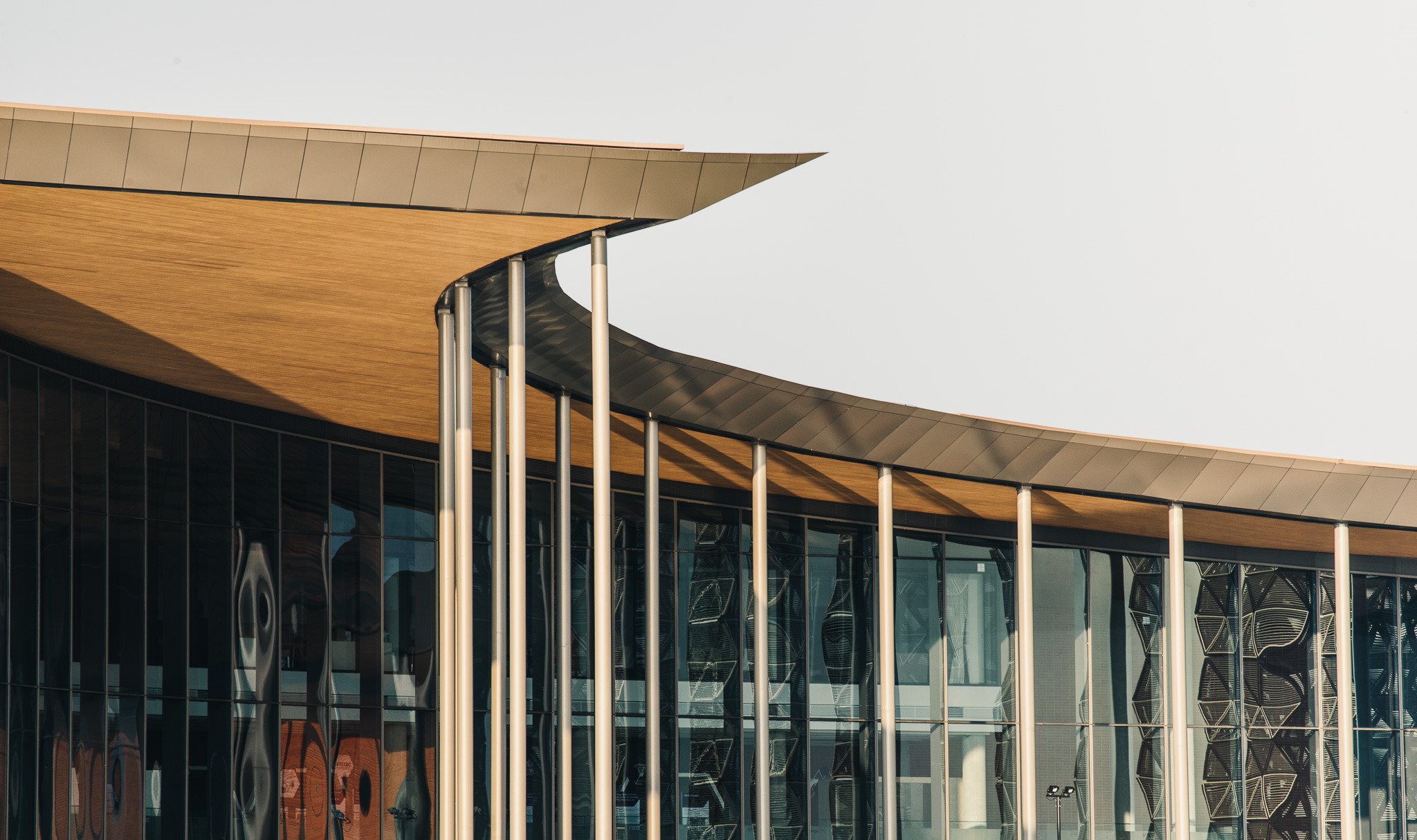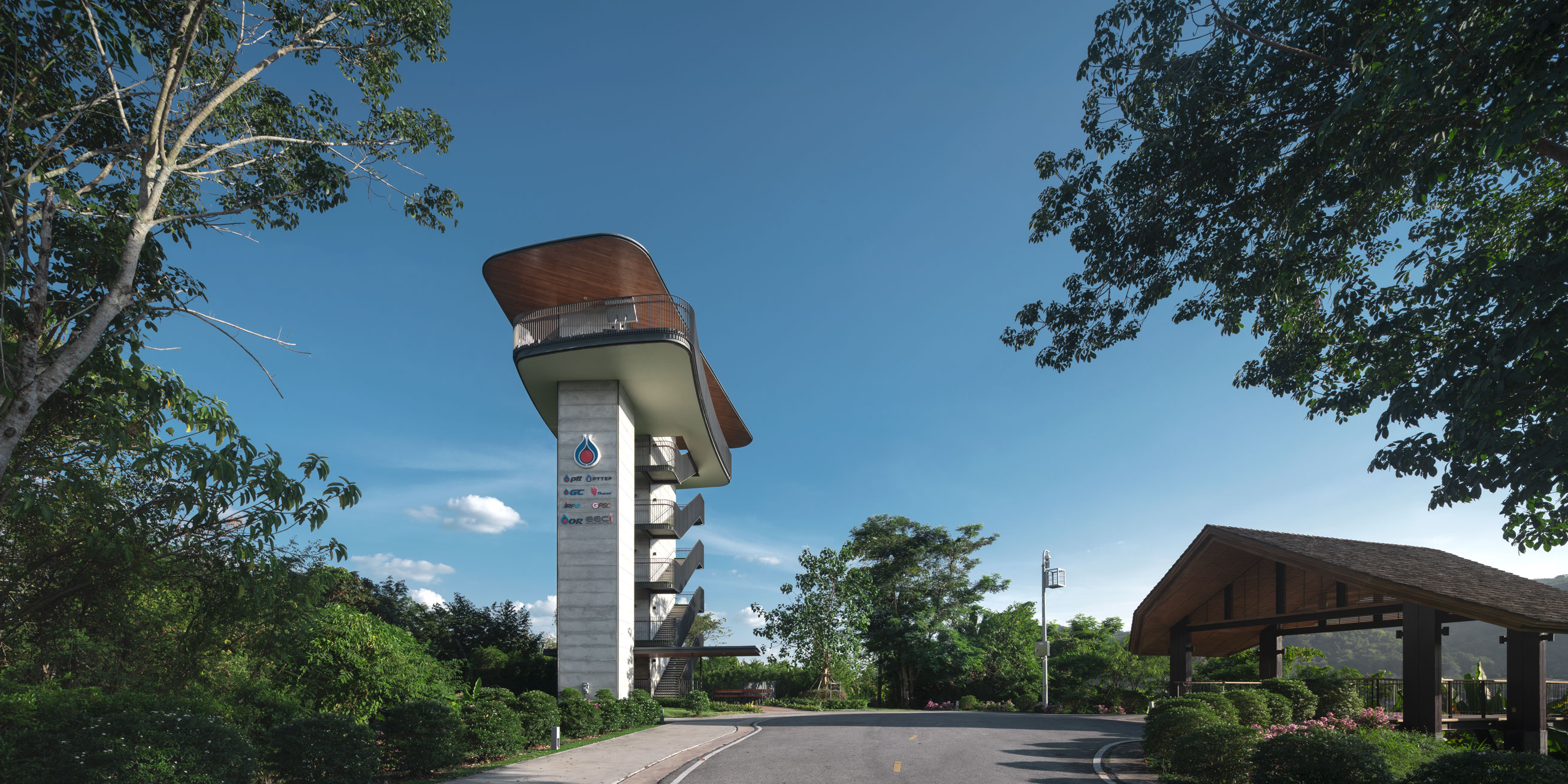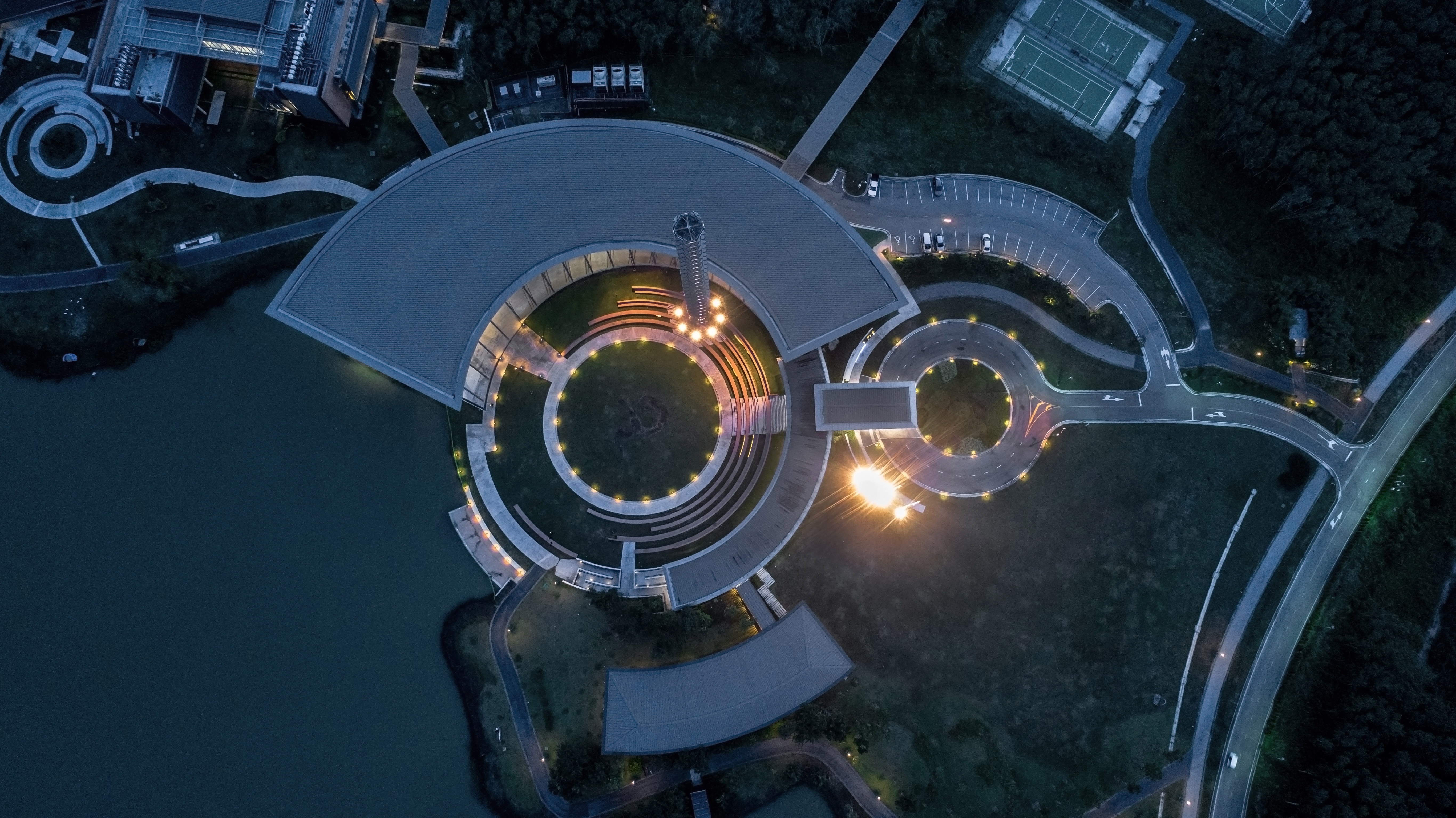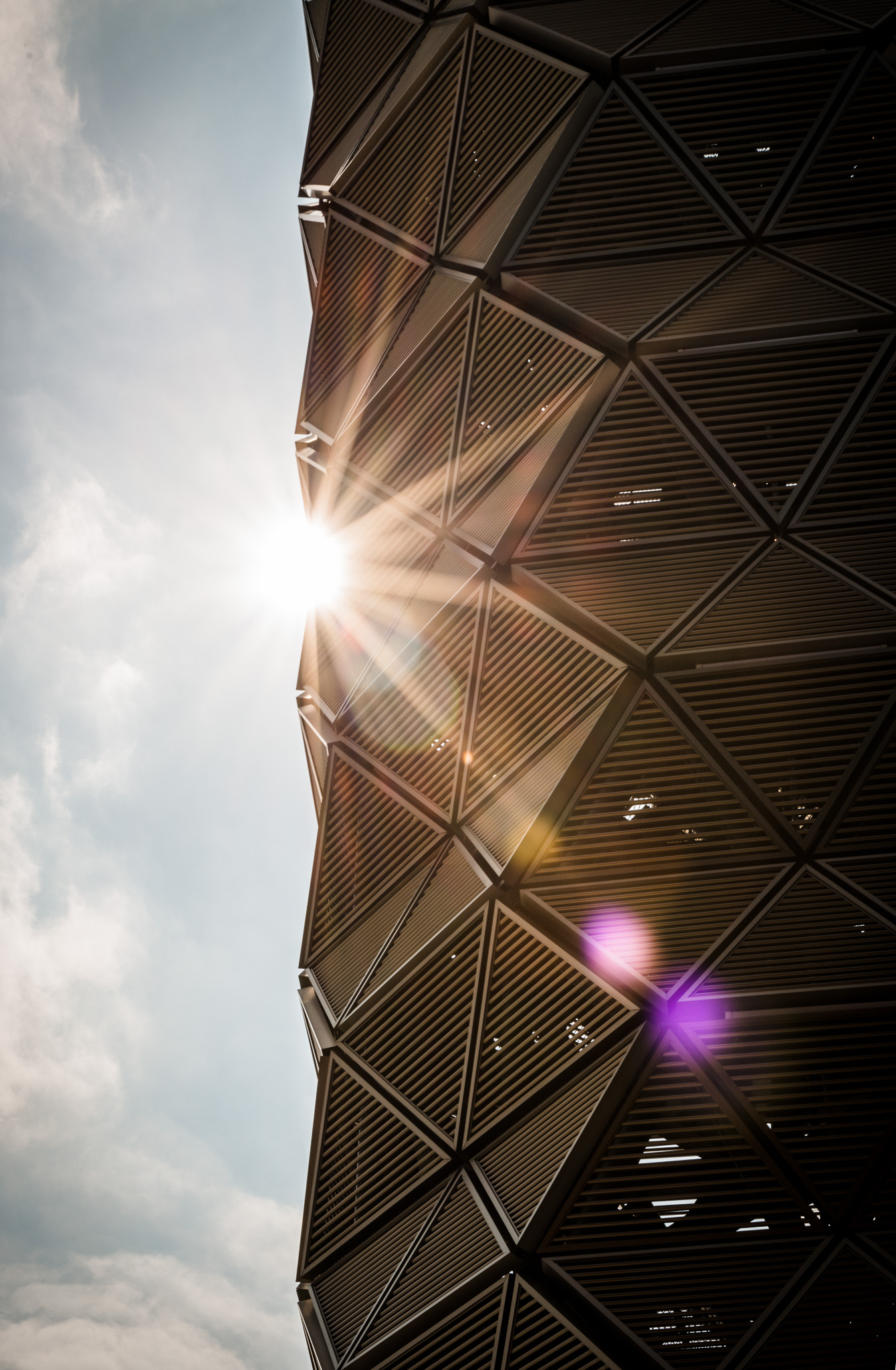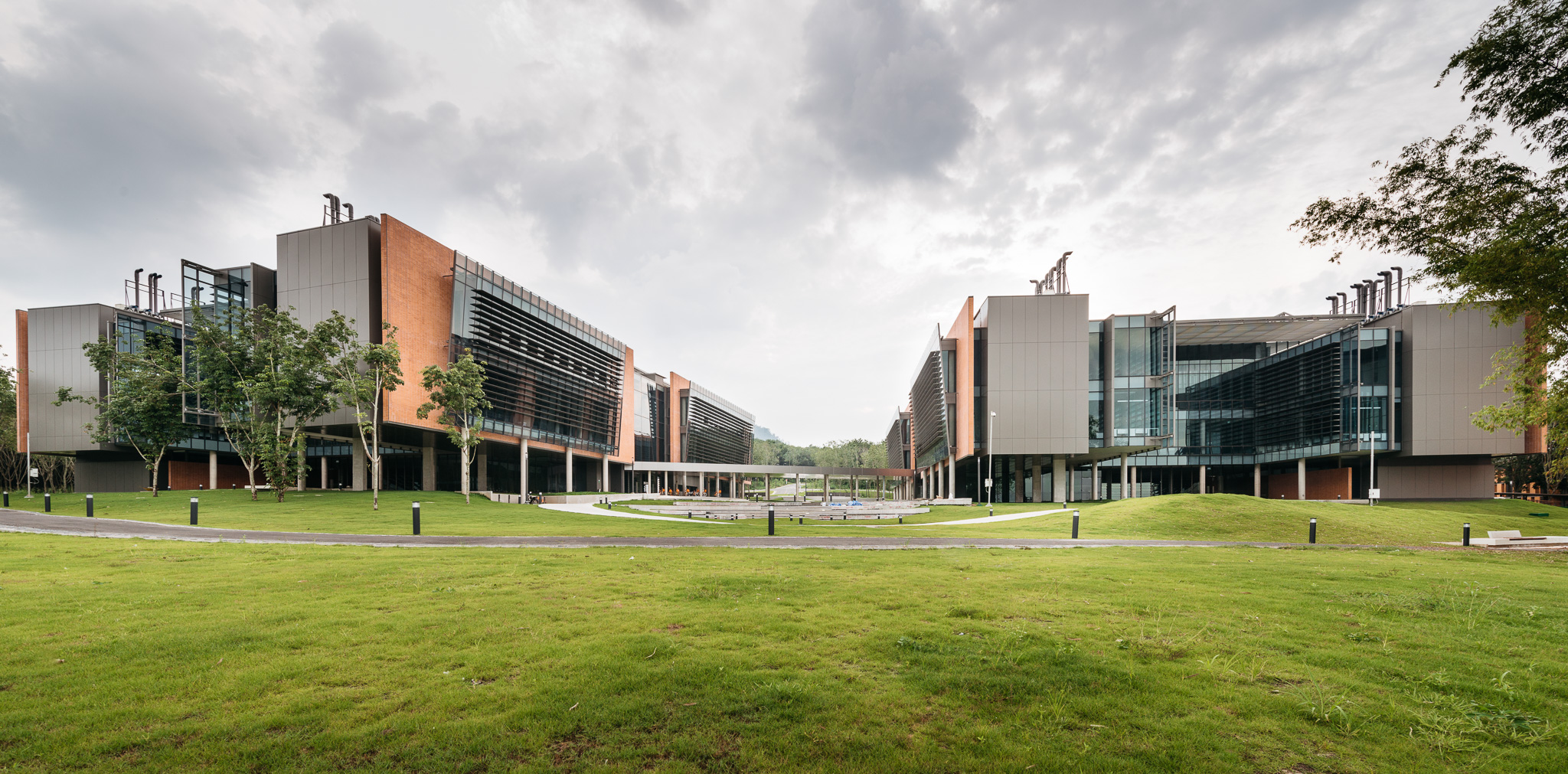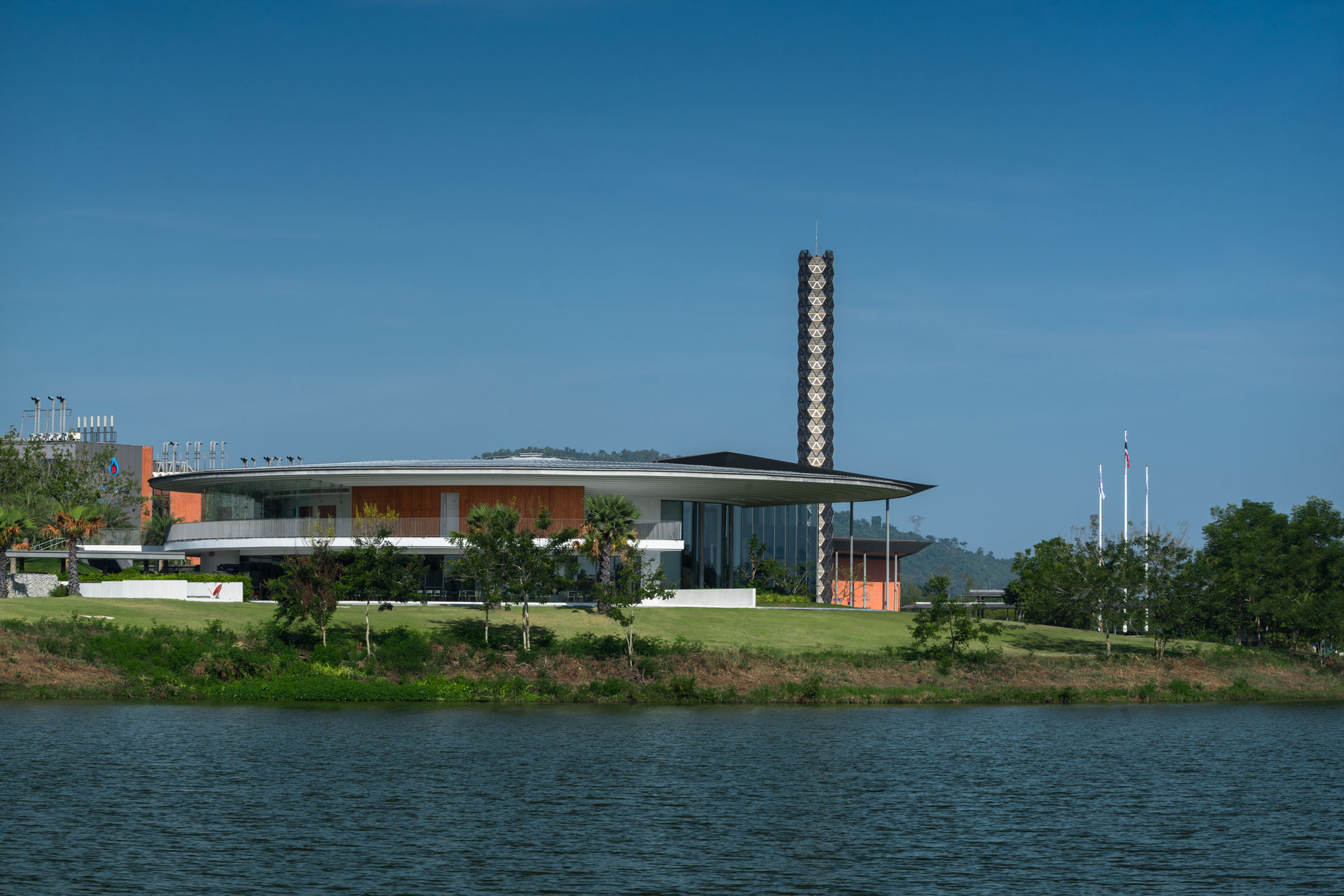

The landmark pylon at VISTEC derives from the physical form of a Carbon Nanotube -- a substance that measures as small as 1 nanometer, or about 1/10,000 of human hair. Initiated by PTT group, VISTEC is designated to be a frontier research institute focusing on molecular (chemical) and material science. The idea of using this scientific form is, thus, a fitting symbol of the institute.
Situated in the heart of the campus, the pylon will act as a landmark, both by day and by night, for the community at VISTEC and the surrounding areas. Up-close, the pylon becomes a focal point of the open-air lobby leading to the library and the auditorium. The components were carefully designed to be prefabricated and installed on site, from the marrow, without the need for scaffolding, and LED lighting tubes were installed at the final stage.
Two main buildings were constructed at this initial stage.
1. The Vidyasirimedhi Building -- A multi-purpose building set as a hallmark of the Vidyasirimedhi Institute of Science and Technology (VISTEC) in Rayong, Thailand. The design intent corresponds with the institute’s vision of fostering a conscious lifestyle through sustainable development.
Under the concept of a preserved forest, the Vidyasirimedhi Building reinforces the relationship between the buildings’ interior spaces, the reservoir, and the expansive ecological forest. It is designed to maximize transparency between indoor and outdoor through a unique circular form that envelops the central courtyard, called Laan Jai Baan, and the nanotube tower. This Laan Jai Baan acts as the central node of axial planes which links all buildings together.
The Vidyasirimedhi Building is also first-of-its-kind amongst higher education institutions in Thailand, awarded the prestigious LEED Gold Certification by the U.S. Green Building Council (USGBC). The design has cost-effectively integrated several sustainable strategies that minimize energy consumption on a limited budget by 22% to meet LEED standard design.
One of the prominent features of the building is the extensive roof overhang, that modulates with the form of the building, to reduce direct sunlight and external heat into the building. The orientation of the building also plays a significant role in minimizing energy consumption by planning enclosed space, such as locating maintenance and storage rooms to the southwest, while allowing spaces that require fenestration to face the central courtyard to the north. The library, E-library, and the cafeteria are set near the central courtyard so professors, students and researchers can meet and interact.
2. The Laboratory Building in Vidyasirimethi Institute of Science and Technology is formed out of a cluster of lab rooms, students and post-doctorate researchers’ workspace and offices, enabling faculty to engage in a community-like atmosphere.
Education 3.0, a new approach to learning that embraces technology and social collaboration, is also implemented as a significant part of the design. Public areas, which are typically transitional spaces, are adapted into collaborative spaces to learn and teach outside of classrooms so researchers can generate new ideas through keen interaction. The public area is treated as an atrium that connects all the laboratory clusters together, facilitating a variety of activities such as temporary exhibitions, conferences, lectures and social interactions with other users.
A feature staircase in the atrium, with seating capacity, is also intentionally designed to further support interaction and create a lively atmosphere befitting the concept of Education 3.0. Another major consideration was to incorporate sustainable features that improve users’ well-being. This was achieved by designing the atrium to facilitate natural ventilation through stack effect and allowing diffused natural light to pass through aluminum tubes down from clerestory to the space. This method diffuses direct sunlight into indirect light, pleasantly distributed to areas of the building where it is required.
Design Concept
Labspace
Asst.Prof.Chatchai Wiriyakraikul
SYSTRA MVA (Thailand)
Fielding Nair International
Stonehenge Inter
iECM
Ritta





In 1980, Prabhakorn received his Bachelor of Architecture degree from Chulalongkorn University. He continued his education at the Catholic University of America in Washington DC, where he graduated with a Master of Architecture degree in 1984. Whilst in Washington DC, Prabhakorn worked at Robert Schwinn & Associates in Maryland before returning to Thailand and joining A49 in 1985. At A49, he has been responsible for a wide range of projects ranging from mega complexes and high-rise buildings to houses. Most of these are located in Thailand, whilst others are located in other countries in the region, including: China, Malaysia, Singapore and Vietnam. His work has also extended outside that region, for example, to the United Arab Emirates and India. All add breadth to the A49 portfolio of work. His main role has been to establish major policies, design concepts and strategic planning initiatives. He was appointed as President of Architects49 Phuket in 2005 and President of Architects49 International in 2006.
Prabhakorn actively served the Association of Siamese Architects (ASA) as its Head of Public Relations from 1992 to 1994, as its Vice President of Foreign Affairs from 1995 to 1997, and as the President of ASA during 2002-2004. He has also participated in many subcommittees for both the ASA and the Architect Council of Thailand (ACT). He is an active Council Member of the ACT, with his present duties for them extending into 2018. He has been an Honorary member of the Japan Institute of Architects (JIA) since 2003.
Prabhakorn has been a key member of A49 since its foundation, and has the honour of being trusted by Nithi Sthapitanonda (the Founder of A49) to be President and Managing Director of 49Group.
In 1980, Prabhakorn received his Bachelor of Architecture degree from Chulalongkorn University. He continued his education at the Catholic University of America in Washington DC, where he graduated with a Master of Architecture degree in 1984. Whilst in Washington DC, Prabhakorn worked at Robert Schwinn & Associates in Maryland before returning to Thailand and joining A49 in 1985. At A49, he has been responsible for a wide range of projects ranging from mega complexes and high-rise buildings to houses. Most of these are located in Thailand, whilst others are located in other countries in the region, including: China, Malaysia, Singapore and Vietnam. His work has also extended outside that region, for example, to the United Arab Emirates and India. All add breadth to the A49 portfolio of work. His main role has been to establish major policies, design concepts and strategic planning initiatives. He was appointed as President of Architects49 Phuket in 2005 and President of Architects49 International in 2006.
Prabhakorn actively served the Association of Siamese Architects (ASA) as its Head of Public Relations from 1992 to 1994, as its Vice President of Foreign Affairs from 1995 to 1997, and as the President of ASA during 2002-2004. He has also participated in many subcommittees for both the ASA and the Architect Council of Thailand (ACT). He is an active Council Member of the ACT, with his present duties for them extending into 2018. He has been an Honorary member of the Japan Institute of Architects (JIA) since 2003.
Prabhakorn has been a key member of A49 since its foundation, and has the honour of being trusted by Nithi Sthapitanonda (the Founder of A49) to be President and Managing Director of 49Group.

In collaboration with Landscape Architects 49, we have extensive experience in master planning and urban design. We have worked for both government and private sectors from large urban development to planning of new university campus.
